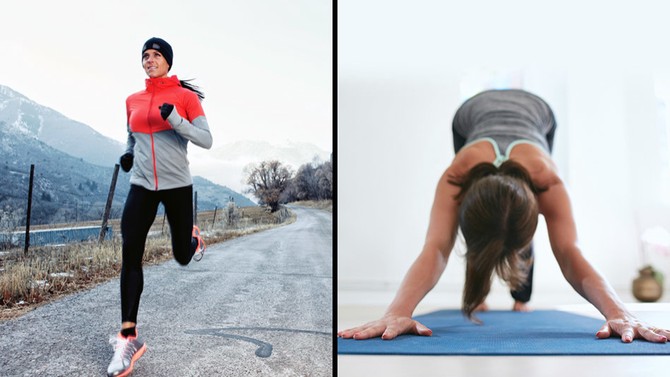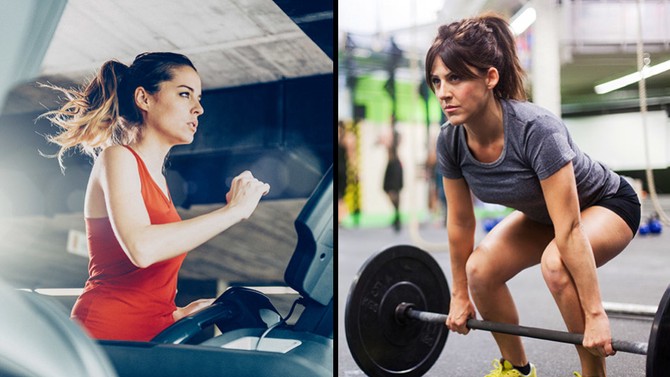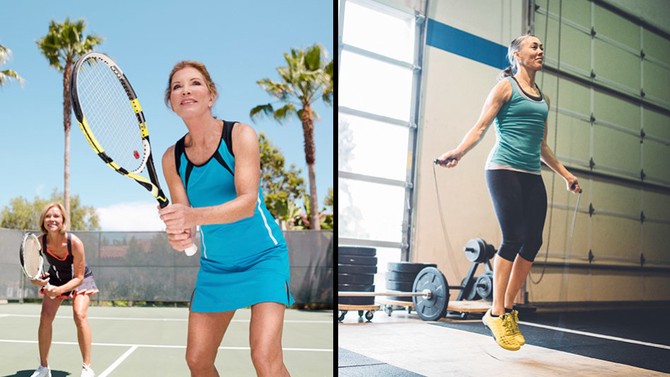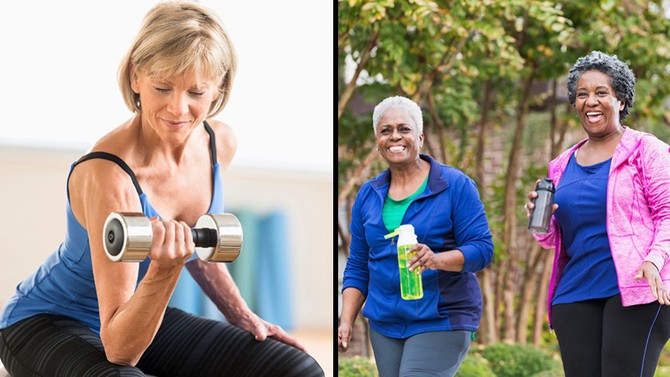The Best Exercise for Your Age
Any kind of exercise is a step in the right direction, but some workouts can be more beneficial than others at different points in your life.
By Alice Oglethorpe

Left: Andrew Rich/istockphoto / Right: Jacob Ammentorp Lund
Decade: 20s
What to do: Lace up your running shoes
Why: Your current cardiovascular fitness level can help predict how healthy you'll be later. In a recent study in JAMA Internal Medicine, people in their 20s did a treadmill test in which researchers gradually increased the speed and incline and tracked how long the participants could last. When the researchers followed up with the subjects years later, in midlife, they found that those who lasted at least 10 minutes had a 50 percent lower risk of death and 40 percent lower risk of cardiovascular disease compared with those who could only complete 6 minutes of the test.
The Plan: The researchers recommend doing 30 minutes of moderate cardio exercise (like a brisk walk that includes some hills) 5 days a week, or 25 minutes at an intensity that leaves you a little more exhausted 3 times a week.
What to do: Take up yoga
Why: Today's 20-somethings graduated into a pretty bleak job market, and they're saddled with huge amounts of student-loan debt. Not so shocking then that a sense of calm may not come easily for them. "We see a lot of students in their 20s who don't know how to relax," says Jay Gupta, a cofounder of YogaCaps, a nonprofit that works with hospitals and community organizations to teach yoga to those with chronic diseases. Chronic stress is linked to sleeplessness, depression, a weaker immune system and even digestive issues. Learning healthy ways to cope with stress will benefit you now and in the long term. Enter yoga: Research suggests that it might help regulate stress responses in the body, like elevated cortisol levels and high blood pressure.
The Plan: Gupta says practicing a little yoga every day would be ideal, but 2 sessions per week is a good start. We have a 3-pose routine to help you de-stress. If you're a yoga newbie, here are a few yoga cues that even regulars find confusing, explained.

Left: ferrantraite/istockphoto / Right: Tempura/istockphoto
Decade: 30s
What to do: Add intervals to your cardio workouts
Why: You know this is the decade when your metabolism starts to slow down, but you may not realize how important it is to counteract the decline. "Due to the slower metabolism, you could gain up to 2 pounds of fat every year," says Mike Siemens, director of exercise physiology at Canyon Ranch Health Resort, in Tucson, Arizona. Interval training helps your body keep burning calories after you stop exercising. The effect continues for 10 to 12 hours after an interval workout, compared with 4 or 6 hours after a regular one.
The Plan: Push yourself to an 8 or 9 on the exertion scale (you shouldn't be able to carry on a conversation), then lower to a 6 or 7 (you can say 10 words or so without being out of breath), and repeat. Alternate between those two levels for 20 to 40 minutes 2 to 3 days a week. Start with whatever ratio of work time to recovery time works best for you and progress from there. Here's a trick to make treadmill intervals a little easier.
What to do: Lift heavy weights
Why: "Around 30, you start to lose up to one-third of a pound of muscle a year—that's why most people get weaker as they age," says Siemens. "You might think anything that works your muscles, like Pilates or a boot camp class, is enough to build muscle back up, but those activities only maintain your muscle mass." Lifting weights can help rebuild what you've lost. You want a weight heavy enough that you can't do more than 8 to 12 reps in a row.
The Plan: The best moves are ones that work your largest muscle groups, so focus on your chest, legs, back and shoulders, doing 2 to 3 sets of moves that work those areas a few times a week. Grab your heavy dumbbell and try these 3 full-body exercises.

Photo: alvarez/istockphoto
Decade: 40s
What to do: More exercise—any kind will do
Why: It'll help protect your telomeres, the stretches of DNA on the ends of our chromosomes that get shorter with age and leave cells vulnerable to damage. In a study in Medicine & Science in Sports & Exercise, the more physically active people were during middle age, the lower their risk for shortened telomere length and the healthier their cells stayed as they aged.
The Plan: Focus on the 4 activities tracked in the study: weight training, moderate cardio like jogging, vigorous cardio like Spinning or a trendy rowing class and walking or biking.

Left: AMR Image/istockphoto / Right: RyanJLane/istokphoto
Decade: 50s
What to do: Tennis, dancing, hiking
Why: Weight-bearing exercises like these help you maintain bone density, which generally starts to drop once you enter menopause (declining estrogen levels play a role). Why are weight-bearing exercises so helpful at this point? "Bone is living tissue, and it only keeps itself as strong as it needs to be," says Elizabeth Matzkin, MD, chief of women's sports medicine at Brigham and Women's Hospital in Boston. "So if you regularly stress your bones, they'll maintain greater strength to keep up with your activities."
The Plan: Aim for 30 minutes of weight-bearing activity daily. If that doesn't work with your schedule, Matzkin says you can get the same benefit with fewer but longer workouts, as long as you lengthen your workouts slowly to avoid injury.
What to do: Exercises that build your leg muscles
Why: The more powerful your legs are, the better your brain will age, found a recent study in Gerontology. Researchers looked at sets of female twins with an average age of 50 and found that within the pairs, the twin with stronger legs had a brain that aged better (both structurally and functionally) over a 10-year period. The strong legs/strong mind connection isn't totally understood, but one theory is that when our muscles are put to work, they release neurochemicals that stimulate brain cells, and since leg muscles are among the largest muscles in the body, they may release more.
The Plan: The researchers recommend doing activities that boost your legs' explosive power, like running, jumping, skipping and dancing 3 times a week for 45 minutes.

Left: tetmc/istockphoto / Right: Susan Chiang/istockphoto
Decade: 60s and beyond
What to do: Regular strength training
Why: Not for the reason you think: You'll give your brain a lift. Women in their 60s and 70s who lifted weights twice a week had fewer white matter lesions on their brains, a warning sign of cognitive decline that is also connected to a higher risk of dangerous falls, according to a study in the Journal of the American Geriatric Society. Those who strength-trained only once a week didn't see the same benefits.
The Plan: Using medium-heavy weights (you should be able to do 10 reps of each move before you need a break), do a variety of moves that work your whole body for 40 minutes, twice a week. Here are a few exercises to get you started: this move that works your arms and abs at the same time; a great shoulder toner; and this combo exercise that strengthens your entire lower body.
What to do: Light activity like walking and gardening
Why: Weight gain after menopause—especially extra weight around your midsection—can increase your risk for health problems like diabetes, heart disease and even certain cancers. It's easier to gain weight after menopause, but there is a silver lining: It's also easier to lose it. Even light physical activity, like walking and gardening, has a bigger impact on the weight and belly fat of post-menopausal women than younger women (per new research presented at the annual meeting of the North American Menopause Society.)
The Plan: Find an activity that gets you up and moving regularly and try to commit to 30 minutes of it every day.
Published 02/16/2016

